#Anas fulvigula
Explore tagged Tumblr posts
Text
BOTD: Mottled Duck

Photo: Andy Reago & Chrissy McClarren
"A close relative of the Mallard, the Mottled Duck is the only dabbling duck specialized for nesting in southern marshes, far to the south of most of its relatives. Unlike most waterfowl, Mottled Ducks are almost never seen in large flocks, generally traveling in pairs or small groups. A major threat to their survival is the release of numerous pet Mallards in Florida and elsewhere in southeast; these feral birds interbreed with Mottled Ducks, diluting the wild population of the latter."
- Audubon Field Guide
#birds#mottled duck#birds of north america#north american birds#ducks#waterfowl#birds of the us#birds of mexico#birding#bird watching#birdblr#birblr#bird of the day#Anas fulvigula
43 notes
·
View notes
Text
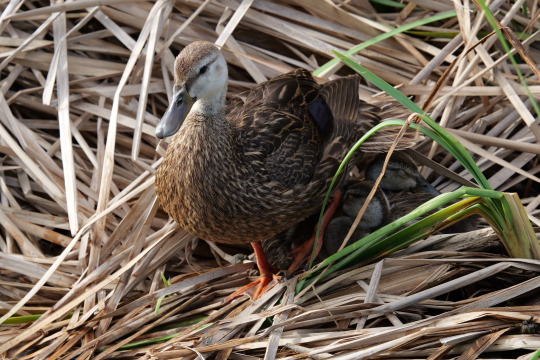
Mottled Duck (Anas fulvigula)
156 notes
·
View notes
Photo

Will Mallards Hybridize Their Cousins out of Existence? | Auk & Condor Updates
In Florida, hybridization between domesticated Mallards and Mottled Ducks is a cause for concern, but the degree of hybridization in the western Gulf Coast region is less well known. Louisiana State University’s Robert Ford and his colleagues took blood samples from Mottled Ducks captured on the coast of Louisiana in 2011–2014, supplementing them with samples from Mottled Ducks and Mallards from Texas, Alabama, and Mississippi. Analyzing the birds’ DNA, they found that the hybridization rate in the western Gulf Coast region is currently only 5–8%, a level lower than what’s been documented in Florida. However, that doesn’t mean the western Gulf population is completely in the clear.
Currently, the two species have little opportunity to interact in the region during the breeding season; Mottled Ducks nest in coastal marshes, while most Mallards are migratory and breed outside the region. However, the ongoing loss of marsh habitat could cause Mottled Ducks to move into urban and suburban areas, where they will be more likely to encounter resident Mallards. To prevent future problems, Ford and his colleagues recommend ongoing monitoring of hybridization in the region and better protection of coastal marsh habitat.
“The biggest challenge in collecting samples was finding molting Mottled Ducks, which we collected during bird banding operations in the summer. Identifying birds as either Mottled Ducks or Mallards in the summer can be difficult, but most of our banders had years of experience and we did not have many problems,” says Ford. “In the future, I would like to see improvements in the methods to identify hybrids, such as more precise techniques that could identify gene combinations unique to hybrids.”
“Hybridization between Mottled Ducks and Mallards is a significant conservation concern in the southern U.S.,” according to waterfowl expert and Auburn University emeritus professor Gary Hepp, who was not involved in the study. “Ford et al. recommend programs to monitor future changes in hybridization, and a proactive management approach similar to Florida’s that controls the number of non-migratory Mallards while prohibiting future releases of game farm Mallards may also be prudent.”
#Mallard#Anas platyrhynchos#Mottled Duck#Anas fulvigula#Anas#Anatinae#Anatidae#Anseriformes#Galloanserae#Aves#birds#duck#waterfowl#hybridization#ecology#conservation#Gulf of Mexico
14 notes
·
View notes
Photo

Arche 1592 — Canard brun (Anas fulvigula).
Mardi 30 juillet 2019, Raphaël Zacharie de Izarra. _________________________________________ Né le 6 décembre 1965 au Mans, Raphaël Zacharie de Izarra est un écrivain et un vidéaste (bien qu'il n'accepte pas d'être défini en ces termes, « trop forts pour qualifier [ses] petits amusements artistiques »). Depuis 2007, il se met en scène dans plusieurs centaines (milliers ?) de vidéos publiées sur Youtube et Dailymotion. Poète oisif hors du monde et du temps, tout l'inspire et devient prétexte à s'enregistrer (il peut sortir jusqu'à trois vidéos par jour). Obsessionnel, il est l'auteur de très nombreuses chroniques (lectures de ses propres textes, purement littéraires ou politiques), mais aussi d'instants de vie capturés sur le vif (des promenades à vélo, des dégustations de bière, des conversations…), ou d'exercices de style (des montages sur de la musique, plus ou moins étranges…).
Reconnu « adulte handicapé », il dédie chaque seconde de son temps à sa production, et il n'est pas rare de croiser ce personnage lunaire dans les rues du Mans, toujours équipé de son caméscope. En 2014, des associations portent plainte contre lui. Il se retrouve ainsi, par deux fois, devant les juges à devoir s'expliquer sur ses textes polémiques (soumis à passer un examen psychiatrique, on le déclare finalement « pénalement irresponsable »).
Sa chaîne Youtube : https://www.youtube.com/channel/UC4ApXwjJfcTKA3jRWMqgL0A Une tentative de centraliser son œuvre : http://izarralune.blogspot.fr/ _________________________________________ « Projet Arche » : un animal dessiné en quelques minutes chaque jour pendant dix ans. http://projetarche.blogspot.fr
0 notes
Photo

Florida Mottled Duck
#duck#morning light#florida#early morning#bird in water#Bird#Mottled Duck#Anas fulvigula#Nikon d500#N
0 notes
Text
Anas
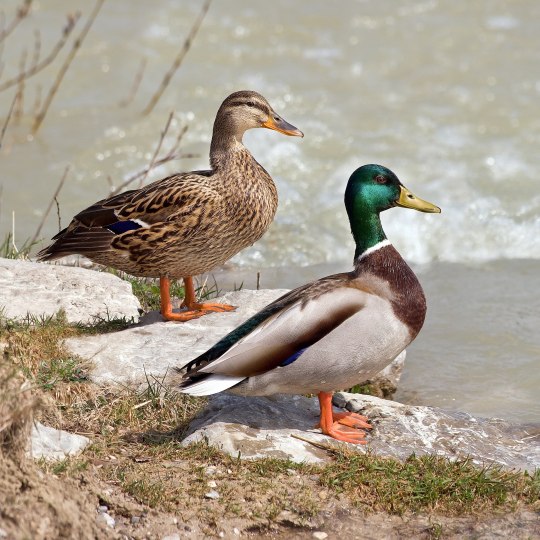
Mallard by Richard Bartz, CC BY-SA 2.5
PLEASE SUPPORT US ON PATREON. EACH and EVERY DONATION helps to keep this blog running! Any amount, even ONE DOLLAR is APPRECIATED! IF YOU ENJOY THIS CONTENT, please CONSIDER DONATING!
Name: Anas
Status: Extant
First Described: 1758
Described By: Linnaeus
Classification: Dinosauria, Saurischia, Eusaurischia, Theropoda, Neotheropoda, Averostra, Tetanurae, Orionides, Avetheropoda, Coelurosauria, Tyrannoraptora, Maniraptoriformes, Maniraptora, Pennaraptora, Paraves, Eumaniraptora, Averaptora, Avialae, Euavialae, Avebrevicauda, Pygostylia, Ornithothoraces, Euornithes, Ornithuromorpha, Ornithurae, Neornithes, Neognathae, Galloanserae, Anseriformes, Anseres, Anatoidea, Anatidae, Anatinae, Anatini
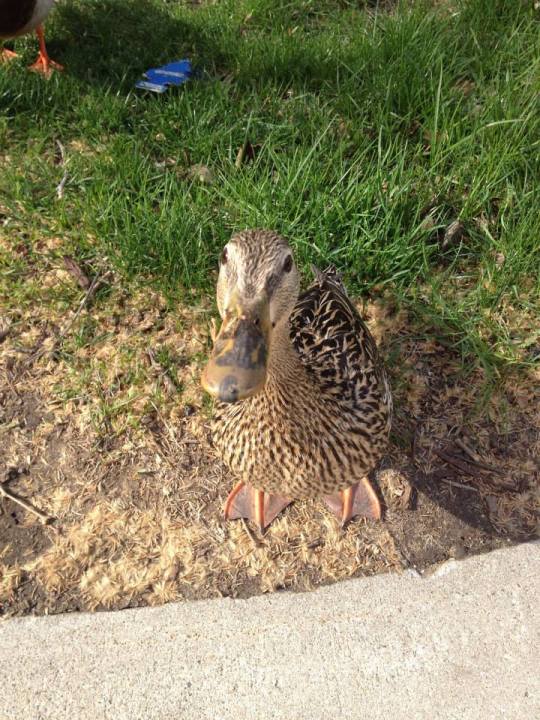
Mallard by Meig Dickson (me!)
Referred Species: A. sparsa (African Black Duck, Extant), A. undulata (Yellow-Billed Duck, Extant), A. melleri (Meller’s Duck), A. superciliosa (Pacific Black Duck, Extant), A. laysanensis (Laysan Duck, Extant), A. wyvilliana (Hawai’ian Duck, Extant), A. luzonica (Philippine Duck, Extant), A. poecilorhyncha (Indian Spot-Billed Duck, Extant), A. zonorhyncha (Eastern Spot-Billed Duck, Extant), A. platyrhynchos (Mallard, Extant), A. fulvigula (Mottled Duck, Extant), A. rubripes (American Black Duck, Extant), A. diazi (Mexican Duck, Extant), A. capensis (Cape Teal, Extant), A. bahamensis (White-Cheeked Pintail, Extant), A. erythrorhyncha (Red-Billed Teal, Extant), A. georgica (Yellow-Billed Pintail, Extant), A. eatoni (Eaton’s Pintail, Extant), A. acuta (Northern Pintail, Extant), A. crecca (Eurasian Teal, Extant), A. carolinensis (Green-Winged Teal, Extant), A. flavirostris (Yellow-Billed Teal, Extant), A. andium (Andean Teal, Extant), A. gibberifrons (Sundra Teal, Extant), A. albogularis (Andaman Teal, Extant), A. gracilis (Grey Teal, Extant), A. castanea (Chestnut Teal, Extant), A. bernieri (Bernier’s Teal, Extant), A. chlorotis (Brown Teal, Extant), A. aucklandica (Auckland Teal, Extant), A. nesiotis (Campbell Teal, Extant), A. theodori (Mascarene Teal, Extinct), A. greeni (Extinct), A. ogallalae (Extinct), A. pullulans (Extinct), A. cheuen (Extinct), A. bunkeri (Extinct), A. pachyscelus (Bermuda Islands Flightless Duck, Extinct), A. schneideri (Extinct), A. elapsum (Extinct), A. gracilipes (Extinct), A. moldovica (Extinct), A. sansaniensis (Extinct), A. strenuum (Extinct), A. itchtucknee (Extinct), A. kisatibiensis (Extinct), A. kurochkini (Extinct), A. lambrechti (Extinct)

Green-Winged Teal by Dick Daniels, CC BY-SA 3.0
Here we are - our last duck, the biggest genus of ducks, the most iconic ducks. The genus Anas. This genus includes pintails, most teals, the mallard, and its close relatives, all fairly standard dabbling ducks. There are 31 living species in this genus, and many more extinct ones besides. The oldest record of this genus occurs in the late Miocene of China, around 12 million years ago, in the Tortonian of the Miocene of the Neogene. As such, it probably originated sometime shortly before then, and probably also in East Asia. Anas rapidly diversified afterwards, reaching Hungary and the United States still within the Miocene, and being fairly widespread worldwide by the Pleistocene, when fossils of this genus increase extensively.
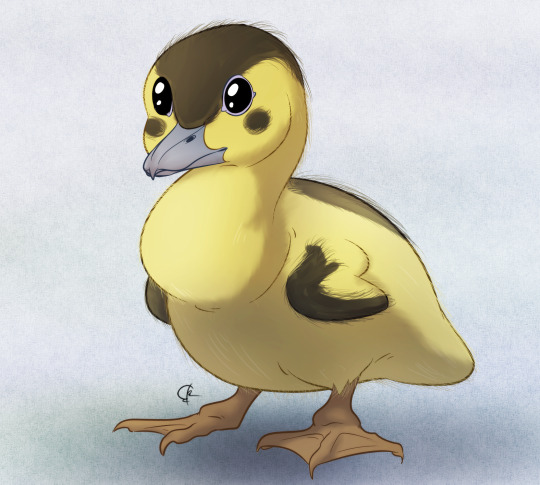
A. pachyscelus by José Carlos Cortés on @quetzalcuetzpalin
Two extinct species in this genus are especially notable. A. pachyscelus, the Bermuda Islands Flightless Duck, from the H. Bernard Wilkinson Quarry of Bermuda in North America, living about 126,000 to 12,000 years ago, in the Tarantian age of the Pleistocene of the Quaternary. A recent duck, it is thus notable due to its weird ecology - like many insular dinosaurs, it lost its ability to fly, and was significantly larger than other species in the genus. It had smaller wings compared to its body than other species in this genus, supporting the idea it was flightless, and was probably more sedentary than other members of Anas, too. It had heavy legs to help it with swimming and walking as well, and probably lived along saltwater lakes. The Mascarene Teal, A. theodori, is another extinct species, known from the islands of Mauritius and Réunion. It was a small teal, due to its island habitat, and it was probably fairly similar to the living Bernier’s Teal of Madagascar. This species of duck probably went extinct primarily to overhunting by humans.
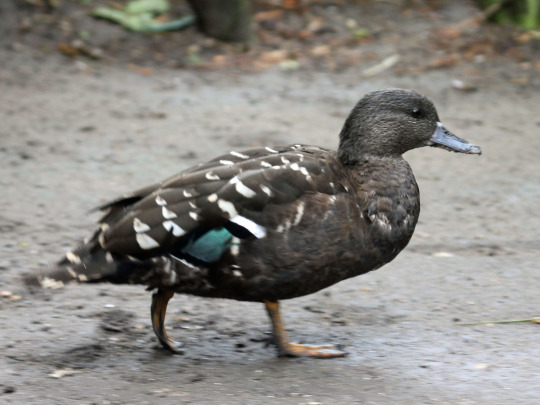
African Black Duck by Dick Daniels, CC BY-SA 3.0
The African Black Duck, A. sparsa, is a nonthreatened duck that’s very close to the Mallard but is distinctive from the Mallard due to its different plumage and behavior. Known primarily from Sub-Saharan Africa, especially from South Africa to Ethiopia and east to Nigeria and Cameroon, it isa . black duck with white stripes and green spots on its wings. They are very shy and territorial ducks in small flocks and pairs, breeding throughout the year with clutches of up to 8 eggs and only the mother taking care of the young. They live primarily in rivers and streams, building their nests out of driftwood and matted grass, and feeding off of larvae and pupae and some plant material.

Yellow-Billed Duck by Thurner Hof, CC BY-SA 3.0
The Yellow-Billed Duck, A. undulata, is a medium-sized dabbling duck, not threatened with extinction, and known primarily from southern and eastern Africa. They don’t migrate, but do wander during the dry season in order to find water. They are also very social birds, forming huge flocks when it’s not the breeding season. They are mainly grey, with dark heads and bright yellow bills. They primarily live in freshwater habitats in open country and dabble on plants during the night time. They nest in dense ground vegetation, laying up to 12 eggs at a time.

Meller’s Duck by Safero, CC BY-SA 3.0
Meller’s Duck, A. melleri, is an endangered species of duck primarily from the western half of Madagascar, mainly along the coast. They are similar to Female Mallards, but both sexes are fairly alike, with brown mottled body plumage and distinctive green patches on their wings. They breed during most of the year, and are very territorial birds, especially during the breeding season. The pairs stay together during this time, as well, to protect the young. Average size ducks, they are endangered due to habitat destruction, as they primarily live in wetland areas, but there are conservation efforts ongoing.

Pacific Black Duck by SuperJew, CC BY-SA 4.0
The Pacific Black Duck, A. superciliosa, is a non-threatened species of duck found across Indonesia, New Guinea, Australia, New Zealand, and other southern Pacific islands. They are oftentimes also called Grey Ducks due to their primarily grey plumage across their bodies. Very social ducks, they live in many wetland environments and nest fairly similar to mallards. They have blue-greenish patches on their wings, and dark bodies in general. They up-end for food, much like other members of this genus, but unfortunately have seen a sharp decline in population in recent years.
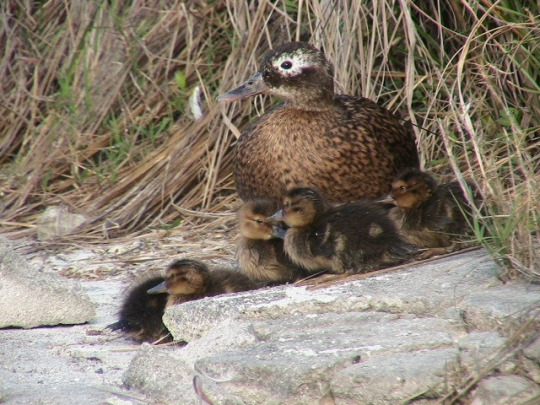
Laysan Duck by Jimmy Breeden, in the Public Domain
The Laysan Duck, A. laysanensis, is a critically endangered duck from the Hawai’ian islands. They used to live throughout the archipelago, but today are only known from Laysan Island, thanks from hunting by humans and introduced predators and competitors. Domestic rabbits were a huge problem for these ducks, and it took the destruction of an introduced population of these mammals for the ducks to begin to recover on Laysan Island. Today, there seem to be at least over 500 ducks, and other smaller populations are currently being introduced in other locations. Threats remain to this duck, but overall their future looks fairly bright due to their extensive persistence up to this point. Recovery plans are ongoing as well. They are bad flyers, but they walk and run fairly well for ducks, and employ standing-still methods when especially threatened. They feed by dabbling and upending, eating primarily vegetation and some invertebrates. They will feed mainly in shallow lakes and along the shore. Pairs will bond in the fall and build nests in the spring, and lay about four eggs per clutch. They are dark brown, with white patches around their eyes.

Hawai’ian Duck by Koloa, in the Public Domain
The Hawai’ian Duck, A. wyvilliana, also known as the Koloa, is a duck known primarily from the large islands of Hawai’i. They are similar in color in both males and females, and do not migrate, unlike their close relative the Mallard. Currently endangered, they are primarily threatened due to introduced predators and competitors on the islands, though hybridizing with mallards has also lead to extreme reduction in their populations - they produce fairly fertile offspring with the much more common ducks. Conservation efforts are ongoing, especially in giving suitable habitat during colder winter months, though it’s difficult to distinguish hybrids from non-hybrid ducks. They are found in low wetlands, river valleys, and streams near mountains, and they have a current population of around two thousand birds. They are very wary birds, found usually in pairs rather than large groups, and are secretive as well. They are opportunistic feeders, eating basically whatever they can find based on the season.

Philippine Duck by Duncan Wright, CC BY 2.5
The Philippine Duck, A. luzonica, is a very large dabbling duck known from the Philippines, and is called in that area the Papan. They have brownish feathers, though not mottled, and red and black striped heads, as well as bright green feathers on their wings. They eat primarily fish and insects in wetlands, and are currently vulnerable to extinction.

Indian Spot-Billed Duck by Davidvraju, CC BY-SA 4.0
The Indian Spot-Billed Duck, A. poecilorhyncha, is a non-threatened visually distinctive species in this genus, due to a small red patch right above the bill, and distinct yellow ends to the bills as well. They also have white spotting in addition to the green spotting in their wings. They are the same size as the mallard, and the females are only somewhat duller than the males. They live throughout Pakistan and India in freshwater wetlands, avoiding open water and preferring locations with extensive vegetation cover. They nest in hidden vegetation, sometimes on tree branches, and the young hatch usually within a month. They make calls similar to mallards as well. They usually form small groups or pairs to feed, and isolate themselves from other ducks.
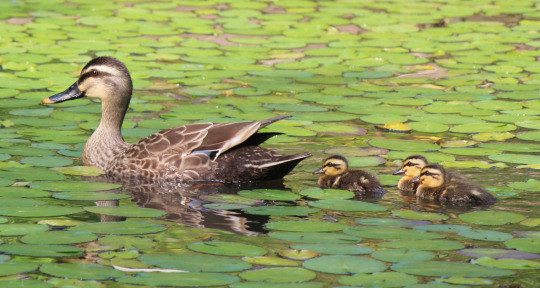
Eastern spot-billed Duck by Alpsdake, CC BY-SA 3.0
The Eastern Spot-Billed Duck, A. zonorhyncha, is a non-threatened sort of duck from China and southeast Asia, and is closely related to the Indian Spot-Billed Duck, but formally separated out as a different species. Still, they also have bright yellow tips to the ends of their beaks. They are the same size as a mallard and mainly grey on their bodies, and haver blue flashy feathers on their wings rather than green. They winter in Southeast Asia and then migrate up to China, though their ranges have expanded thanks to global warming. They live primarily in lakes and marshes, and nest on the grounds near the water.

Mallard by Rror, CC BY-SA 3.0
The Mallard, A. platyrhynchos, is the most famous species of duck, and arguably “the” duck - as in, when people talk about ducks, they probably mean the Mallard. This is due to a variety of reasons - it’s widespread range, extreme population numbers, distinctive male coloration, and domestication by humans all have contributed to its famed status amongst the waterfowl. They live throughout the Northern Hemisphere naturally, though of course it has been introduced in other locations as well. They are medium-sized birds, weighing up to 1.58 kilograms, and the males are fairly unmistakable, with bright green heads, brown bodies, and blue spots on their wings. The females also have blue feathers on their wings, though they are more mottled brown in coloration - and are often confuseable with other birds, especially ones in this very article. These ducks do migrate, depending on where their wintering range is, though some remain in place if they happen to live in a more middle-of-the-road location. Given that these ducks live in the north, sometimes for most of the year, they show two very noticeable features of northern animals - both larger body size than its warmer-climate counterparts, and fewer blood vessels in the extremities (in this case, the bill), making the Mallard an important comparison organism to study adaptations to cold climates in non-Mammalian animals.

Mallard Duckling by Nunnsofunky, CC BY 3.0
Mallards are omnivorous birds, feeding on a variety of food depending on opportunity, including many types of invertebrates and plants, though plants are usually a huge part of their diet during the colder months. They form mated pairs until the females lay eggs at the start of the spring, when the male leaves her to tend of the nest. Usually they lay up to 13 eggs, which are incubated for around a month. the young imprint on their mother, following her around for warmth and protection as well as to learn the ropes of life as a duck. These ducks do show rather unfortunate copulation behaviors, including rape-flights, attempted-rape flights, and even homosexual necrophilia. Though hunted extensively, especially by humans, its population remains on the rise - and even is erasing other duck species through hybridization - so it’s considered a species not threatened with extinction. They also are invading South African populations and decreasing the biodiversity there, due to their adaptiveness, human introduction, and generally non-picky diet. These birds live in a variety of freshwater and saltwater habitats, and congregate in large, noisy flocks; though they sometimes also live in smaller groups.

Domestic Mallards by Johnny Jet, CC BY 2.0
The Mallard is one of two ducks domesticated by humans, the other being the Muscovy Duck. Many breeds of Mallard have been generated, raised for meat, eggs, and down, as well as in some cases companionship. Farmed for thousands of years, they are not as aggressive as mallards and not as territorial, making them fairly safe birds for humans to care for. They are kept in free range as well as in pens, and don’t require swimming water to survive, though of course that makes them happier. Most domestic ducks one would encounter are fairly white in color, though there are of course a variety of breeds and color variations. This absence of darker patches is also seen in ducklings, which lack the black stripes of wild Mallard ducklings. They enjoy living as pets with access to water, where they dabble and eat wildlife. They are unreliable egg producers, not very good at rearing their young in captivity, or even sitting on the eggs - usually incubators are used instead. They are mainly fed grain and insects, and should never be fed bread or other food products that can rot due to water - such things are only given as treats in completely dry environments.

Mottled Duck by Dick Daniels, CC BY-SA 3.0
The Mottled Duck, A. fulvigula, is a non-threatened duck seemingly intermediate between female Mallards and Black Ducks, which its closely related to. They live around the Gulf of Mexico, but also go as far south as Veracruz, though they are very frequent ducks around the former. They have darker plumage than female mallards, but lighter than American Black Ducks. They feed by dabbling in shallow water, but they also graze on plants on the land, and build their nests amongst vegetation such as grasses. These ducks, unlike many, do not migrate.

American Black Duck, by the U. S. Fish and Wildlife Service, in the Public Domain
The American Black Duck, A. rubripes, is a non-threatened common species of duck primarily from North America.These ducks spend the winters in Canada and breed in the United States, with the overlap of the northernmost part of the United States being a year-round habitat. As such, it is closely associated with the Mallard and does hybridize with it, because species are a construct. Distinct from Mallards in terms of plumage, they are more black and greyish in color, though sometimes they have yellow beaks. They also have blue wing feather patches. They are some of the heaviest members of this genus of birds, with the highest average mass of any species in Anas. They live in a wide variety of habitats, including tidal marshes and salt marshes, as well as beaver ponds, shallow lakes, forests, and swamps. They take shelter by moving to conservation lands, as well. They feed on a wide variety of food by dabbling and grazing, including wetland grasses, aquatic plants, and small animals, though they eat more invertebrates during the nesting season. They breed in fairly alkaline marshes, bogs, ponds, and rivers, and they do migrate across their range to reach suitable nesting environments. They nest in concealed areas, with both males and females watching over the nests. They seem to be doing well in terms of conservation, they are strained by the success of the mallard, and conservation efforts are present for this species.

Mexican Duck by Gary L. Clark, CC BY-SA 4.0
The Mexican Duck, A. diazi, is a dabbling duck from Mexico and the southern United States. They live mainly in wetlands, especially ponds and rivers, where it dabbles primarily for plant food. Though similar in appearance to the mallard, the males do not have the distinctive mallard plumage and, furthermore, they are fairly genetically distinct. Instead, these seem to be a radiation from the mallard, distinct due to geographic boundaries. They are showing a small decline in population due to habitat destruction and under hunting.

Cape Teal by Steve Garvie, CC BY-SA 2.0
The Cape Teal, A. capensis, is a non-threatened dabbling duck from the open wetlands of southern Africa. They do not migrate, like other African ducks, though they do follow the rains opportunistically. They look similar across both sexes, with greish bodies, pink bills, and green patches on the wings. They are rarely seen in large flocks except during the moulting season, and are fairly quiet as well. They feed primarily on aquatic plants and small invertebrates by dabbling, and nest under vegetation near sources of water.
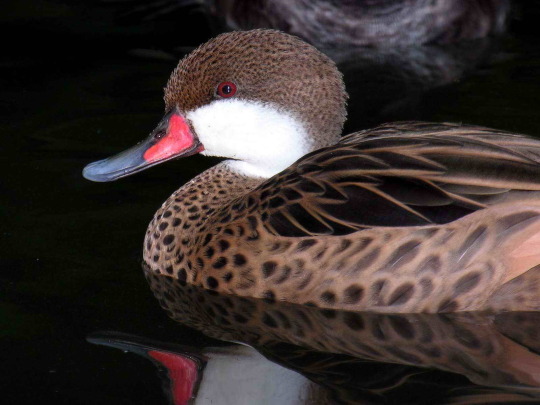
White-Cheeked pintail by Luis Miguel Bugallo Sánchez, CC BY-SA 3.0
The White-Cheeked Pintail, A. bahamensis, is a non-threatened species, primarily from the Caribbean and South America, as well as the Galápagos. They enjoy living in somewhat salty waters such as lakes, mangroves, and estuaries near the shore. They are similar across both sexes, with mainly brown plumage and bright red bills, along with white patches on their faces - leading to their name! They mainly feed on aquatic plants and some small animals through dabbling behavior.

Red-Billed Teal by Dick Daniels, CC BY-SA 3.0
The Red-Billed Teal, A. erythrorhyncha, is a dabbling duck from southern and eastern Africa, and as such does not migrate. They have black and white mottled plumage, with bright red bills. They are fairly quiet ducks, primarily inhabiting open freshwater areas where it dabbls for plants, and nests in dense vegetation near their water habitats.
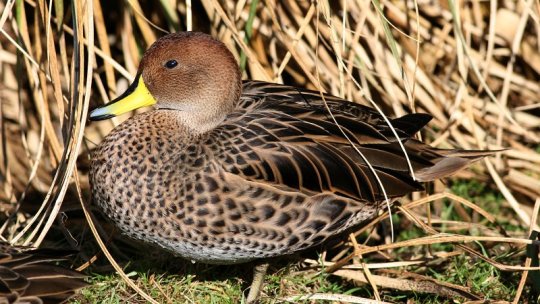
Yellow-Billed Pintail by Ken Billington, CC BY-SA 3.0
The Yellow-Billed Pintail, A. georgica, is a non-threatened species with brown bodies mottled with black feathers, and yellow bills with black stripes. They do not form large groups and are more solitary than other ducks, living across most of South America and southern islands. They live mainly in highly elevated areas near lakes and marshes, though they are sometimes found in lower elevation areas. They form nests on the ground with grass and down, hidden by vegetation, and lay up to 10 eggs in a clutch.

Eaton’s Pintail by N. Hanuise, CC BY-SA 2.5
Eaton’s Pintail, A. eatoni, is a duck vulnerable to extinction, known from the Kerguelen and Crozet islands in the Indian Ocean. It resembles the Northern Pintail a little bit, but appears to be a different species. They are very much threatened by introduced species, especially feral cats, and very little conservation efforts are ongoing at this time.

Northern Pintail by Bert de Tilly, CC BY-SA 4.0
The Northern Pintail, A. acuta, is a non-threatened species of duck from across the world, found breeding in the northernmost parts of North America and Eurasia, and wintering in southern Europe, central America, the southern parts of Asia, and even northern Africa along major waterways. It is a fairly large duck, found on open wetlands in its ranges, and weighing up to 1.36 kilograms. The males and females both are fairly white during the winter, given that they are found in very northern areas, though mottled brown plumage is found on the outsides of their bodies. They walk fairly well for ducks, and swim excellently, and also fly quite quickly, making them decent at getting away. They enjoy mainly open, non-wooded wetlands such as wet grasslands and the tundra. They breed from April to June and the clutch incubates for about a month, though only half reach reproducing age. They feed by dabbling and upending in shallow water for plant food, using their long necks to reach food that Mallards cannot. With their large range, they are doing mostly well, but there is a population decline at hand, especially due to avian diseases and human hunting.
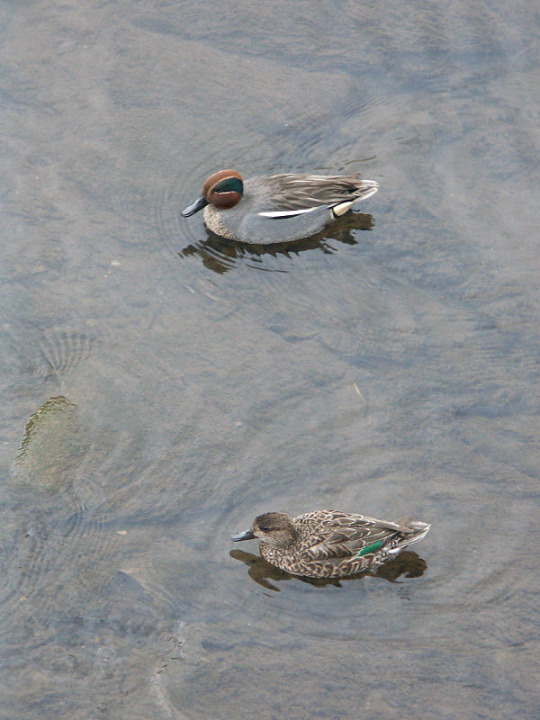
Eurasian Teal by Isaka Yoji, CC BY-SA 2.1
The Eurasian Teal, otherwise known as the Common Teal, A. crecca, is a widespread duck from the Eastern Hemisphere. They breed in northern Eurasia, especially across Siberia, and migrate down to various warm and wet places in southern Eurasia and northern Africa for the winter. They do have year-round ranges as well, especially within Europe. The Eurasian Teal is the smallest living dabbling duck, weighing only about 0.34 kilograms in males. The males have distinctive grey plumage, with brown heads and green patches on their heads. The females are primarily brown, though they do have green patches on the wings as well. The males do look more like the females outside the breeding season. They are very noisy ducks, making whistling and quacking calls essentially constantly. They are very social ducks as well, forming extensive flocks living together in sheltered freshwater wetlands with tall vegetation, though they move to saltier environments during the winter. They feed through dabbling, upending, and grazing, mainly on invertebrates and more plants in the winter. They nest near the water and in covered areas, laying clutches usually of around 10 eggs, which are watched by both parents.

Green-Winged Teal by Alan D. Wilson, CC BY-SA 2.5
The Green-Winged Teal, A. carolinensis, is a common and well-known North American species of duck. It nests in Canada and spends the winters in the southern United States and Mexico, though this duck can be found year- round along the coasts of the United States. The females are light brown and similar to Mallards in terms of plumage, while the males are grey and brown, with brown heads and distinctive green stripes on their heads and wings. They are very migratory birds, and the smallest dabbling ducks known in North America. They mainly eat food on mud flats, unlike almost every other species of ducks, but will feed in marshes and flooded agricultural areas where mud flats are lacking. They primarily eat vegetations such as seeds, stems, and leaves, including pondweeds. They live mainly in inland lakes, marshes, ponds, and shallow streams, though they prefer more shallow locations during the breeding season. They make nests out of depressions on dry ground near the bases of shrubs. The Green-Wing Teal do winter in both freshwater and somewhat salty areas. Being strongly migratory birds, they are some of the earliest to begin moving in the spring, reaching their nesting grounds as soon as the snow melts.

Yellow-Billed Teal by Duncan Wright, CC BY-SA 3.0
The Yellow-Billed Teal, A. flavirostris, is a non-threatened species from Argentina, the Falkland Islands, Chile, Peru, Bolivia, Uruguay, and Brazil. It lives primarily in wetland environments, rather than rivers, and have a unique courtship behavior compared to other members of its genus: after copulation is over, the males will stretch high and swim around with the females.
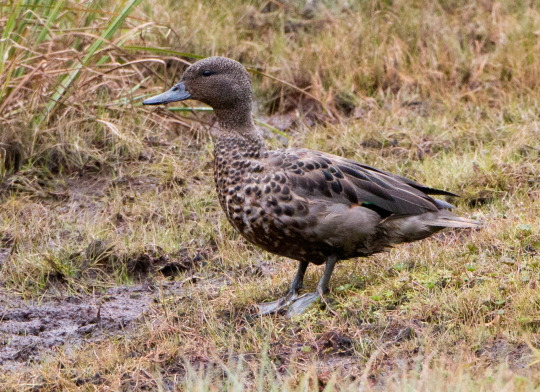
Andean Teal by Gary L. Clark, CC BY-SA 4.0
The Andean Teal, A. andium, is a non-threatened duck from the Andean highlands of Colombia, Venezuela, and Ecuador. It lives primarily near wetlands, rather than rivers, and is dark brown with black patches on its wings, and has a dark grey bill. They seem to be closely related to the Yellow-Billed Teal.

Sunda Teal by Mat & Cathy Gilfedder, CC BY-SA 3.0
The Sunda Teal, A. gibberifrons, is a near-threatened dabbling duck from Indonesia. They are brown and mottled ducks, with green flashes on wings visible during flight. They are usually very similar looking regardless of sex. They live primarily in freshwater lakes and marshes, and will nest near these habitats, or in tree holes and rabbit burrows. They are quite vocal at night, rather than during the day.
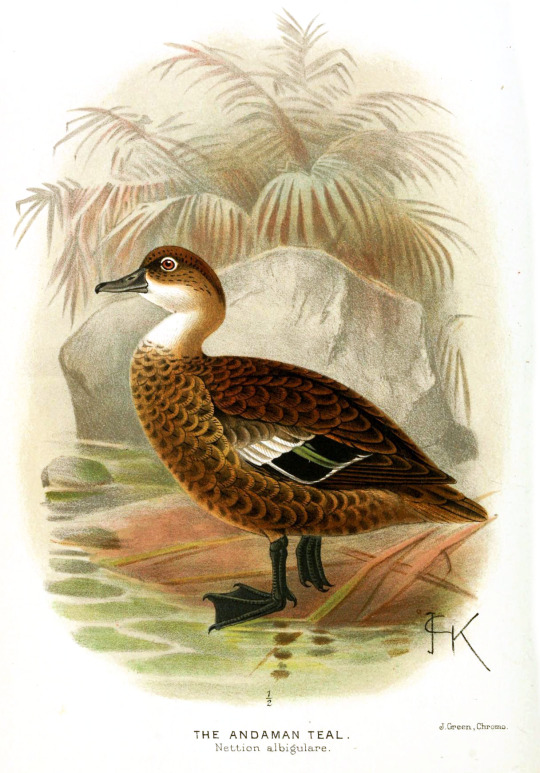
Andaman Teal by John Gerrard Keulemans, in the Public Domain
The Andaman Teal, A. albogularis, is a vulnerable species of duck known entirely from the Andaman archipelago in the Bay of Bengal. A brown duck, with greenish patches on the wings, there are only about 600 birds present in their islands, though that population may have increased into the thousands in recent years. They feed mainly in rice fields, making nests of grass, and eat primarily molluscs and arthropods.
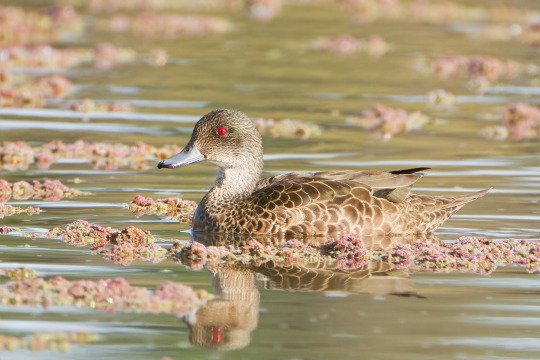
Grey Teal by J. J. Harrison, CC BY-SA 3.0
The Grey Teal, A. gracilis, is a non threatened duck from open wetlands in Australia and New Zealand. They are brown with white and green bits on the wings, with both the males and females looking essentially the same, though the juveniles are in general more pale. They enjoy freshwater lakes and marshes, and will nest on the ground or in holes and burrows near these wet areas. They are very vocal at night, and live in very large social groups.
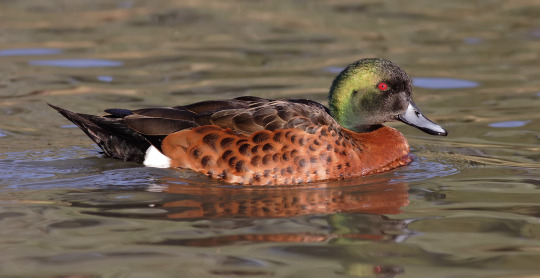
Chestnut Teal by Fir0002, GFDL 1.2
The Chestnut Teal, A. castanea, is a non threatened species from Australia, especially in southern Victoria and in Tasmania, though they are sometimes found more northward. They live in coastal estuaries and wetlands and are omnivorous in their feeding habits. They have brown bodies, while the males have distinctively green heads. The females also make really loud laughing quacks. They form monogamous pairs that look after and defend the young together, which are usually nested near the water.

Bernier’s Teal by BS Thurner Hof, CC BY-SA 3.0
Bernier’s Teal, A. bernieri, is an endangered species known only from along the Western coast of Madagascar. They are small ducks, weighing only up to 0.4 kilograms, and they are mainly light brown or greyish, with slightly red bills. They live mainly in mangrove forests and rarely leave, spending their times in shallow ponds and lakes that are somewhat salty. They actually used to be more widespread on the island, prior to human interference. They feed during most of the day, wading at the edge of the water and filtering for invertebrates and plants. They make nests near water in mangrove trees, as well as nest boxes, which are covered with wood shaving and down feathers. The clusts usually have up to 9 eggs, and only the female incubates the eggs. on the verge of extinction thanks to habitat destruction and hunting, there are many captive breeding programs to help bump up populations.

Brown Teal by Sabine’s Sunbird, CC BY-SA 3.0
The Brown Teal, A. chlorotis, is an endangered species known primarily from New Zealand. In Māori, it is known as the Pāteke. Their numbers fell due to heavy harvesting for food by European colonizers, and they became protected in the early 1900s. A primarily brown bird, they are mainly nocturnal to allow for hiding from predators. They dabble and upend to feed mainly on aquatic invertebrates such as crustaceans, insects, and molluscs. They make nests of dry grass near water, and lay clutches of up to 8 eggs. The males wills tay around to help guard the territory from other ducks. There are fewer than 1000 birds left, thanks to introduced predators, but conservation efforts are ongoing.

Auckland Teal by John Gerrard Keulemans, in the Public Domain
The Aukland Teal, A. aucklandica, is a dabbling duck native to the Auckland Islands near New Zealand. Vulnerable to extinction, it is reduced in its rage compared to its native populations, only found on those islands without introduced predators such as Adams Island, Enderby Island, and Disappointment Island. Fairly nocturnal ducks, they use their night-time lifestyle to hide from predators. Small birds, they are brown all over, with only some hints of green, and the females are darker than the males. They actually can’t fly, either, and they live in fields, shrublands, and coastal waters, and tend to feed mainly on small animals. They are territorial ducks, and rarely form flocks.

Campbell Teal by Stomac, in the Public Domain
And finally, our last species is the Campbell Teal, A. nesiotis, an endangered flightless species from the Campbell Island of New Zealand. A brown duck with green heads, it is very similar to the Brown Teal, and they may even constitute a single species. It was driven to extinction on its home island due to the introduction of rats. It was only rediscovered on Dent Island with a small population that could have been driven to extinction very easily; some individuals were captured and then taken into captivity for breeding purposes. Captive breeding has been difficult, with many techniques being used; by 2011, however, the breeding programs plus the removal of rats from Campbell island has lead to the successful reintroduction of the Campbell Teal to its native island.
Buy the author a coffee: http://ko-fi.com/kulindadromeus
Sources:
https://en.wikipedia.org/wiki/Anas
Wetmore, A. 1960. Pleistocene birds in Bermuda. Smithsonian Miscellaneous Collections 140 (2): 1 - 11.
https://en.wikipedia.org/wiki/Bermuda_flightless_duck
https://en.wikipedia.org/wiki/Mascarene_teal
https://en.wikipedia.org/wiki/African_black_duck
https://en.wikipedia.org/wiki/Yellow-billed_duck
https://en.wikipedia.org/wiki/Meller%27s_duck
https://en.wikipedia.org/wiki/Pacific_black_duck
https://en.wikipedia.org/wiki/Laysan_duck
https://en.wikipedia.org/wiki/Hawaiian_duck
https://en.wikipedia.org/wiki/Philippine_duck
https://en.wikipedia.org/wiki/Indian_spot-billed_duck
https://en.wikipedia.org/wiki/Eastern_spot-billed_duck
https://en.wikipedia.org/wiki/Mallard
https://en.wikipedia.org/wiki/Domestic_duck
https://en.wikipedia.org/wiki/Mottled_duck
https://en.wikipedia.org/wiki/American_black_duck
https://en.wikipedia.org/wiki/Mexican_duck
https://en.wikipedia.org/wiki/Cape_teal
https://en.wikipedia.org/wiki/White-cheeked_pintail
https://en.wikipedia.org/wiki/Red-billed_teal
https://en.wikipedia.org/wiki/Yellow-billed_pintail
https://en.wikipedia.org/wiki/Eaton%27s_pintail
https://en.wikipedia.org/wiki/Northern_pintail
https://en.wikipedia.org/wiki/Eurasian_teal
https://en.wikipedia.org/wiki/Green-winged_teal
https://en.wikipedia.org/wiki/Yellow-billed_teal
https://en.wikipedia.org/wiki/Andean_teal
https://en.wikipedia.org/wiki/Sunda_teal
https://en.wikipedia.org/wiki/Andaman_teal
https://en.wikipedia.org/wiki/Grey_teal
https://en.wikipedia.org/wiki/Chestnut_teal
https://en.wikipedia.org/wiki/Bernier%27s_teal
https://en.wikipedia.org/wiki/Brown_teal
https://en.wikipedia.org/wiki/Auckland_teal
https://en.wikipedia.org/wiki/Campbell_teal
#anas#duck#bird#dinosaur#mallard#birblr#dabbling duck#palaeoblr#paleontology#prehistory#prehistoric life#dinosaurs#biology#a dinosaur a day#a-dinosaur-a-day#dinosaur of the day#dinosaur-of-the-day#science#nature#factfile#Dìneasar#דינוזאור#डायनासोर#ديناصور#ডাইনোসর#risaeðla#ڈایناسور#deinosor#恐龍#恐龙
85 notes
·
View notes
Photo

Mottled Duck ... Anas fulvigula by sheriffsmith 7-19-17 Green Cay Wetlands ... Lots of little ones around right now. https://flic.kr/p/X7UqUL
1 note
·
View note
Photo
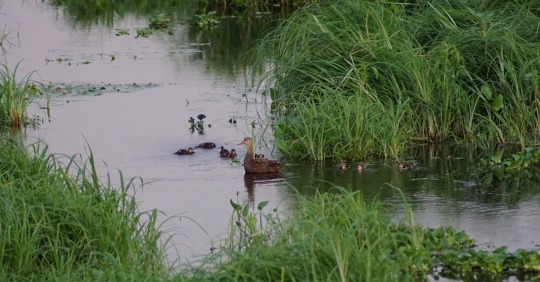
Mama Mottled Duck (Anas fulvigula)
Paynes Prairie Preserve State Park, FL
#Anas fulvigula#mottled duck#duck#ducklings#bird#birding#Ornithology#hiking#nature#wildlife#paynes prairie#paynes prairie preserve state park#Florida#north florida#gainesville#mine#photography#original photographers#photographers on tumlbr
12 notes
·
View notes
Photo

Entre las especies de patos encontramos el Ánade Jaspeado (Anas fulvigula) que es una de las especies de aves en la tribu Anatini. En esta tribu es donde se agrupan los patos de río o patos de superficie. Estos patos por lo general sólo sumergen la cabeza y el cuello en busca de alimento, en diferencia a otros patos que se zambullen.
El Ánade Jaspeado es natural de América del Norte. Su distribución comprende el sur de Estados Unidos y noreste de México. En los Estados Unidos es natural en la Florida y en la región costera del Golfo de México desde Alabama hasta la frontera con México en Texas. En México se le documenta en la costa del Golfo de México desde la frontera con Estados Unidos hasta el estado de Tamaulipas.
4 notes
·
View notes